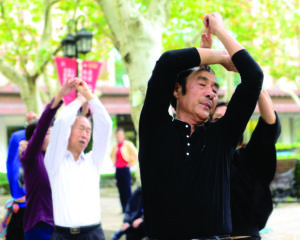By night, Shanghai looks almost like a giant fun-fair when the lights on the city’s skyscrapers and towers are lit in the evening. A walk along the most famous street and waterfront promenade The Bund, that stretches along the Huangpu River and is a tributary of the mighty Yangtze, can almost seem with the festive firework display, and colour and light that gives one a real thrill.
READ MORE: Looking ahead to the Chinese New Year with our special edition
Here it’s safe to walk the streets and at no time do you feel alone, because there are people everywhere. The side-streets vibrate with life, and the smell of exotic spices and scents from the many street kitchens piques the senses and the entire body, so it is not difficult to fall in love.
Shanghai is nothing less than a cornucopia of ultra-modern shopping centres with every major brand and luxury goods item from around the world. But for tourists, probably the most interesting thing is to experience the countless small restaurants and shops in, for example, the French quarter, with its cosy alleyways and beautiful buildings.
The Jewish museum on Shanghai Road and China’s tallest skyscraper Shanghai Tower – the second-largest building in the world only surpassed by Burj Khalifa in Dubai – are amongst the ten most traditional sights in Shanghai. But if you want to forget the historical sights for a moment, it is a good idea to visit one of the many parks in the city, which by comparison, can make parks in Europe appear like waste-grounds.
Tai chi and calligraphy
For example, there is Fu Xing Park which is definitely a wonderful experience. Here, the Chinese show themselves from their creative side, with song, dance, sport, tai chi and calligraphy from morning to evening, so the park is a ‘must see’ if you really want to experience Chinese culture in a no-nonsense way. It is here behind the park’s closed walls that the Chinese dare to open up to strangers. But because of the linguistic and cultural differences that can arise between tourists and the Chinese, from time to time communications can only be effected as a comic circus language. But the main thing is that there is contact.
Chinese folk dancing, the dominant form of dance in Fu Xing park, takes place on the paths under the soft French plane trees. The music is supplied on makeshift systems that must not play too loudly in order that the other activities taking place close by – and the neighbours – are not disturbed. But the dancing takes place in a quiet, orderly fashion, and it is almost a meditative and blissful experience to feel the atmosphere in the park.
Two middle-aged ladies throw themselves into dancing a kind of tango, unaware that they are being observed by tourists and other casual passers-by. A man and woman dance just as energetically with a swing in their hips, all the while making sure to look each other deeply in the eyes. A dance instructor, who has been giving a lesson to a special dance troupe on the square a bit further along, finally seems satisfied with the efforts of his dancers. Unfortunately, he has had to raise his voice to an elderly gentleman who has been having difficulty learning the dance steps. But finally, he has succeeded.
Revolutionary songs
A group of singers goes the whole hog and sings revolutionary songs from the Maoist-era. They are accompanied by a pianist playing an electric keyboard and a flautist. All the singers and the audience surrender completely to the rhythms, but in a controlled and polite way. This is perhaps understandable as a police officer has just parked his scooter behind their backs to make sure that all is as it should be.
There are lots of creative activities going on in the park. An elderly man is standing behind a hedge practising tai chi while he looks after his grandchild who lies asleep in the pram. And round the corner, a man is squatting and writing Chinese calligraphy on tiles. He is very accommodating and really wants to tell us about his art. But it is a little difficult to understand what he is saying as he only speaks Chinese.
In any case, it is clear that the Chinese use the park in a way that we might use an allotment plot, where they let their hair down artistically and creatively. Everybody appears to be allowed to join in. Even so, it is primarily only the older people and grandparents who are here and who have to look after their small grandchildren while the parents are at work. In that way, the park functions as a sort of nursery, at any rate during the daytime.
Fu Xing park is indisputably a fantastic place, with a lovely warm atmosphere. It is almost impossible not to be impressed by the energy shown by the older Chinese people in letting their talents unfold. So if one day you are lucky enough to be able to take a trip to China, remember to visit the city’s parks. They can provide you with a fantastic experience and tell you a little about everyday life amongst the Chinese. What a pleasure it must be to grow old in an environment like that.

















